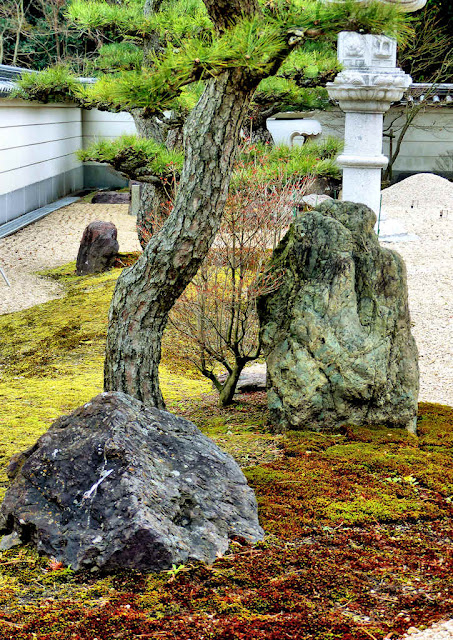With a beautifully restored thatched Nio gate, Hannya-ji Temple is located on a mountaintop between Yanai and Hirao in Yamaguchi.
When I arrived on the afternoon of the 21st November, the 19th day of my walk along the Chugoku Kannon Pilgrimage, the autumn colours were full on.
The Niomon has a pair of fine Nio said to date to the Kamakura Period, though they have been renovayed multiple times since then. The gate itself dates to 1813.
Hannyaji is one of the extra temples added on to the 33 numbered temples.
It claims to have been founded in 567 and the temple is mentioned in documents from the late 6th century so there seems to be some basis for the date.
The temple is named after a beautiful princess, Hannyahime, and the story has several versions which I will pick and choose from for my version....
A wealthy man in what is now Oita, Manano Choja, had a beautiful daughter whose beauty was known of even in the capital. The prince who would become Emperor Yomei secretly visited the area and the couple fell in love and she became pregnant. The prince had to return to the capital and the princess said that if the child was a boy she would bring him up to the capital as an heir for the prince, but if it was a girl then she would leave her with her parents as an heir.
She gave birth to a daughter, so she left on the journey up to the capital. In the area near where Hannyaji now stands the boat encountered a storm. Some say she was washed up on shore and died shortly after, others that she sacrificed herself to the underwater Dragon King to save the lives of others. Her grave is said to be where the Kannon-do now stands.
Emperor Yomei himself ordered the construction of the temple. It is said that the statue of Kannon resembles the princess.
The view from the temple. Down below is where Princess Hannya is said to have died.
I had come across the story of Princess Hannya and her father before at several sites in Kyushu.
Manano Choja is said to have been responsible for the founding of
Renjoji Temple in Bungo Ono. His grave is said to be there. He is also said to have donated the
1,000 Medicine Buddhas there when his daughter was sick. Near to the temple is a twenty metre tall statue of the princess. I didnt photograph it at that time but have since been back and photographed it. At some point down the line I will post it.
The above structure is the Myoken-do which has since been demolished. In its place a new hexagonal building, the Juo-do, has been built.
The temple was given extensive lands, but by the 14th century it had fallen into disuse and was uninhabited. Above is the Kannon Hall.
It was rebuilt and by the 15th century had grown powerful again with 120 branch temples.
It was supported by the Ouchi and then the Mori clans.
Above is the main hall enshring Dainichi Nyorai.
The bell in the bell tower, which I didnt photograph, is dated to 1255
The statue of Enma is now housed in the new Juo Hall.
If you would like to subscribe by email just leave your email address in the comments below. It will not be published and made public. I post new content almost everyday, and send out an email about twice a month with short descriptions and links to the last ten posts.






































































